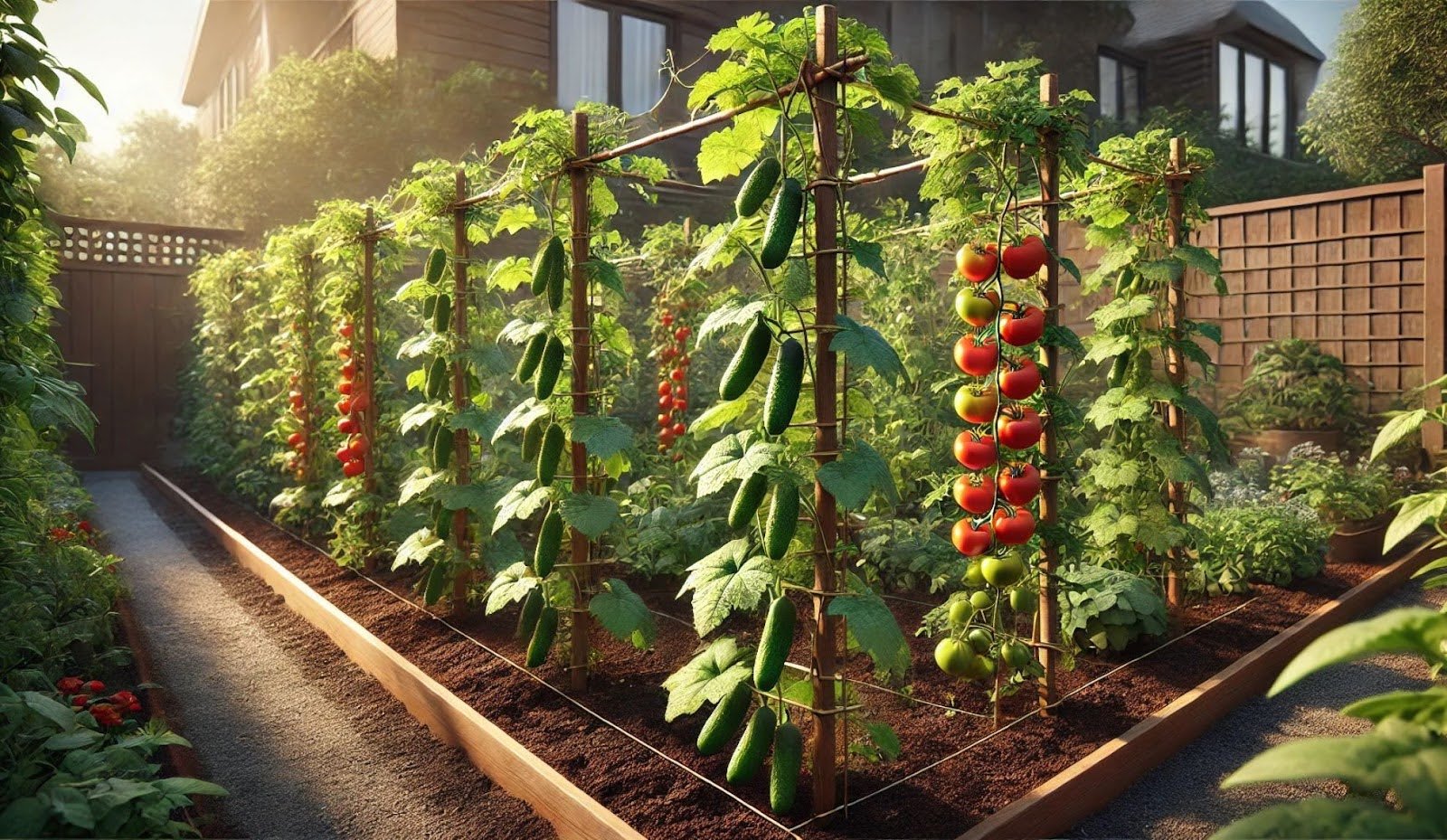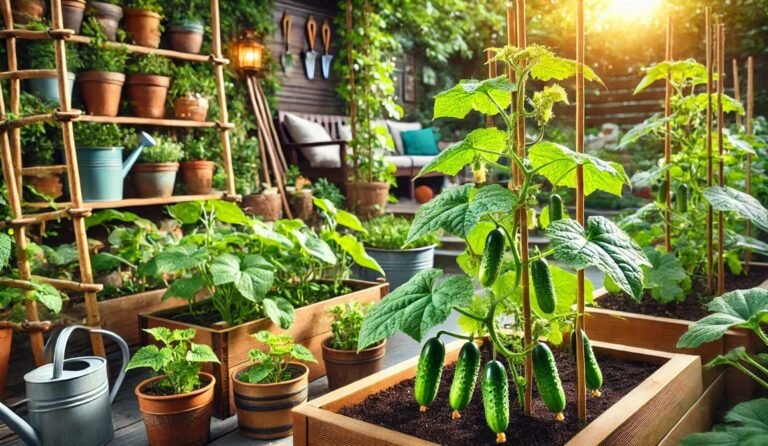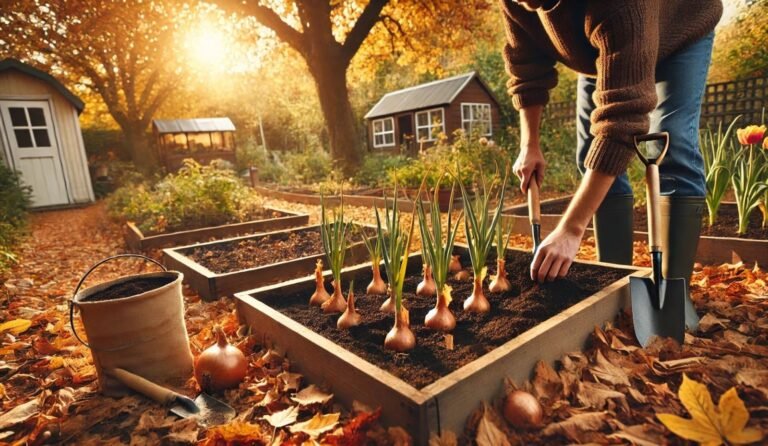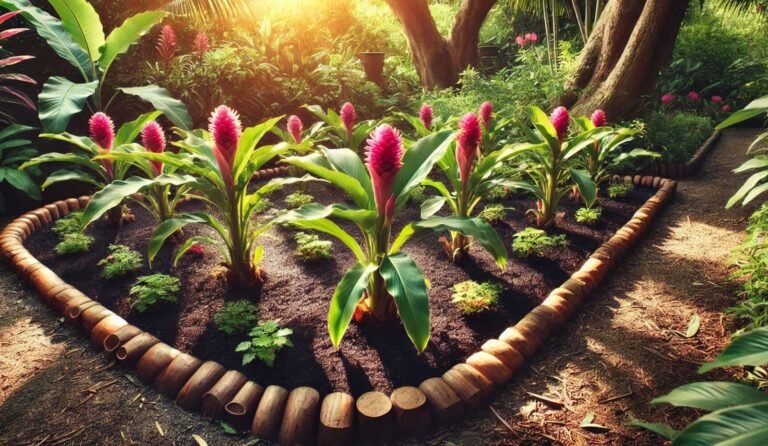Can Cucumbers and Tomatoes Be Planted Together? A Gardener’s Guide
Can cucumbers and tomatoes be planted together? The short answer—yes, but it’s not that simple. While they thrive in similar conditions, they can also compete for nutrients and attract the same pests. Get it right, and you’ll have a thriving, space-saving garden. Get it wrong, and you might end up with stunted plants or a fungal disaster. Stick around to learn the do’s, don’ts, and secrets to growing these two garden favorites side by side!
The Basics of Companion Planting
Before we get into the specifics of planting cucumbers and tomatoes together, it’s important to understand companion planting—a method where different plants are grown together to enhance growth, improve pest resistance, and maximize space. Some plants make great neighbors because they provide mutual benefits, while others can be problematic if they compete for the same resources.
Cucumbers and tomatoes are often considered compatible companions because they share similar needs. Both love warm weather, require plenty of sunlight, and thrive in nutrient-rich, well-draining soil. However, growing them together isn’t as simple as just placing them side by side. It requires careful planning to ensure they don’t interfere with each other’s growth.
The Benefits of Planting Cucumbers and Tomatoes Together
Planting cucumbers and tomatoes together is a smart way to maximize space, improve growth, and boost garden health. Since cucumbers climb trellises and tomatoes grow upright on stakes or cages, they don’t compete for ground space, making them ideal for small gardens. Both plants thrive in similar conditions, needing 6-8 hours of sunlight and nutrient-rich, well-draining soil. Their shared care routine makes watering and fertilizing easier.
Additionally, tomatoes may help deter cucumber beetles, while companion plants like basil and marigolds can repel aphids and whiteflies. Cucumbers also create a microclimate with their broad leaves, providing shade and moisture retention, which benefits tomatoes during hot weather. With proper planning, this pairing leads to higher yields, efficient space use, and natural pest control.
Growing Requirements
Cucumbers and tomatoes have similar growing requirements, making them good companions when planted together—if managed properly. Both plants love warm weather, needing temperatures between 70-85°F (21-29°C) for optimal growth. They also require at least 6-8 hours of direct sunlight daily to produce healthy fruits.
Soil Conditions
Both cucumbers and tomatoes thrive in well-draining, nutrient-rich soil with a slightly acidic to neutral pH (around 6.0 to 7.0). Before planting, enrich the soil with compost or organic matter to ensure they receive the necessary nutrients. Using mulch around the plants helps retain moisture, regulate temperature, and prevent weeds from stealing nutrients.
Watering Needs
These plants need constant watering, but there’s a catch—too much moisture can lead to fungal diseases like powdery mildew and blight. It’s best to water at the base of the plants rather than overhead to keep the foliage dry. Cucumbers prefer slightly more water than tomatoes, so deep watering 2-3 times a week is ideal, depending on the weather conditions.
Support and Trellising
Since both plants grow vertically, they need proper support to maximize space and airflow. Cucumbers do best with trellises, allowing their vines to climb and reducing the risk of disease. Tomatoes, depending on the variety, require stakes, cages, or a string system to keep them upright and prevent fruit from touching the ground.
Fertilization
Both cucumbers and tomatoes are heavy feeders and require a steady supply of nutrients throughout the growing season. Using a balanced fertilizer (such as 10-10-10 or compost tea) every few weeks ensures they get the necessary nitrogen, phosphorus, and potassium. However, avoid excessive nitrogen, as it can lead to lush foliage at the expense of fruit production.
By meeting these growing requirements, you’ll create the perfect conditions for cucumbers and tomatoes to thrive together in your garden!
Planting Placement

Getting the placement right when planting cucumbers and tomatoes together is crucial for healthy growth and maximum yield. Since both plants grow vertically and need space to spread, strategic positioning helps prevent overcrowding, improve airflow, and reduce the risk of disease.
Best Way to Arrange Cucumbers and Tomatoes
To make the most of your garden space, plant cucumbers and tomatoes in a way that supports their natural growth habits. A good method is to position tomatoes on one side of the bed and cucumbers on the other, with trellises or supports in between to keep them from becoming entangled.
If you’re using a raised bed, keep at least 12-18 inches of space between the plants. For larger gardens, leaving 2-3 feet between rows allows for proper air circulation and easy access for maintenance and harvesting.
Using Trellises and Vertical Support
Cucumbers naturally vine and spread, so giving them a sturdy trellis helps keep them off the ground, reduces disease risk, and makes harvesting easier. Tomatoes, especially indeterminate varieties, benefit from stakes or cages to keep them upright and prevent fruit rot. Keeping their support systems separate prevents cucumbers from climbing onto tomato plants and blocking sunlight.
Sunlight and Shade Considerations
Since cucumbers and tomatoes both require at least 6-8 hours of sunlight per day, avoid planting them in areas with excessive shade. However, in extremely hot climates, cucumber vines can offer light shade to tomato plants in the afternoon, preventing sunscald on delicate tomato fruits.
Container Gardening Placement
If you’re growing cucumbers and tomatoes in containers, choose large pots (at least 5 gallons per plant) to give their roots enough space. Place containers a few feet apart to ensure adequate airflow and prevent overcrowding. Using a trellis or stake in each container helps support vertical growth and keeps plants from competing for space.
By planning the right planting placement, you’ll create a balanced environment where cucumbers and tomatoes can thrive together without interfering with each other’s growth.
Determinate Tomato with a Vining Cucumber
Growing determinate tomatoes with vining cucumbers is a great way to maximize space, but it requires careful planning. Determinate tomatoes grow to about 3-4 feet, producing fruit all at once before stopping growth, while cucumbers send out long vines that need a trellis for support.
Since tomatoes stay compact, they won’t overshadow cucumbers, making them good garden companions—as long as they’re spaced at least 12-18 inches apart for proper airflow. Both plants are heavy feeders, so enriching the soil with compost or organic fertilizer helps prevent competition for nutrients. Watering at the base instead of overhead reduces the risk of fungal diseases like powdery mildew and blight.
Keeping cucumbers on a trellis and tomatoes supported with stakes or cages prevents overcrowding, makes harvesting easier, and ensures both plants get enough sunlight. With proper spacing, support, and care, these two crops can grow together successfully, providing a high yield without getting in each other’s way.
Indeterminate Tomato with a Bushing Cucumber
Pairing indeterminate tomatoes with bushing cucumbers is a great way to maximize space. Tomatoes grow tall and produce fruit all season, while bushing cucumbers remain compact and spread horizontally. To prevent overcrowding, stake or cage tomatoes and keep at least 18-24 inches of spacing for good airflow, reducing the risk of powdery mildew and blight.
Both plants are heavy feeders, so enrich the soil with compost or organic fertilizer and water at the base to prevent fungal diseases. Since bushing cucumbers don’t climb, they won’t compete for vertical space, but they can spread out. Using mulch helps retain moisture and keeps cucumber vines in check. With the right spacing and care, these two plants can thrive together for a continuous harvest all season long.
Indeterminate Tomato with a Vining Cucumber
Growing indeterminate tomatoes with vining cucumbers works well if managed properly. Tomatoes grow tall and continuously produce fruit, while cucumbers climb and spread, requiring trellises to prevent overcrowding. To avoid competition, use separate supports—stake or cage tomatoes and train cucumbers on a sturdy trellis.
Keep at least 18-24 inches between them for airflow and water at the base to prevent fungal diseases like powdery mildew and blight. Since both are heavy feeders, enrich the soil with compost or organic fertilizer and use mulch to retain moisture. With proper spacing, support, and care, these two plants can grow together successfully, providing a steady harvest all season long.
Determinate Tomato with a Bushing Cucumber
Pairing determinate tomatoes with bushing cucumbers works well for compact gardens. Tomatoes grow 3-4 feet tall, while bushing cucumbers spread low and wide without climbing. To prevent disease, space them 12-18 inches apart for airflow, stake tomatoes for support, and use mulch to retain moisture.
Both are heavy feeders, so enrich the soil with compost or fertilizer and water at the base to prevent fungal issues. With proper care, these two plants can grow side by side efficiently, offering a productive and easy-to-manage harvest.
Spacing of Plants
Proper spacing is key when planting cucumbers and tomatoes together. If they’re too close, they’ll compete for nutrients, block airflow, and increase the risk of diseases like powdery mildew or blight. Ideally, cucumbers and tomatoes should be planted at least 12 to 18 inches apart, but more space is even better if you have room.
Since cucumbers grow as vines, they should be trained onto a trellis or support system to prevent them from sprawling and tangling with tomato plants. Tomatoes, on the other hand, do best when supported by stakes, cages, or string supports to keep them upright. If you’re growing them in a raised bed or container, choose a large enough space to accommodate their root systems and prevent overcrowding.
Good airflow between the plants is just as important as spacing. When plants are packed too tightly, humidity builds up, creating the perfect environment for fungal diseases. By keeping enough distance between cucumbers and tomatoes, you ensure both plants get enough sunlight, airflow, and nutrients to thrive.
Challenges of Growing Cucumbers and Tomatoes Together
While cucumbers and tomatoes can grow well together, they come with challenges that need careful management. Disease spread is a major concern, as both plants are prone to fungal infections like powdery mildew and blight. To prevent this, ensure proper spacing for airflow and water at the base to keep leaves dry. Another issue is competition for nutrients.
Both plants are heavy feeders, so enriching the soil with compost and using mulch can help retain moisture and nutrients, ensuring they don’t compete too much. Trellising and support are also important—cucumbers tend to climb anything, including tomato plants, which can lead to overcrowding. Using separate trellises and stakes keeps their growth controlled.
Pollination can also be affected, as cucumbers need pollinators while tomatoes are self-pollinating. If tomato plants overshadow cucumber flowers, pollination may suffer. To counter this, plant pollinator-friendly flowers like sunflowers or lavender nearby. With proper spacing, support, and soil management, these challenges can be minimized, allowing both plants to thrive together in your garden!
Best Practices for Planting Cucumbers and Tomatoes Together
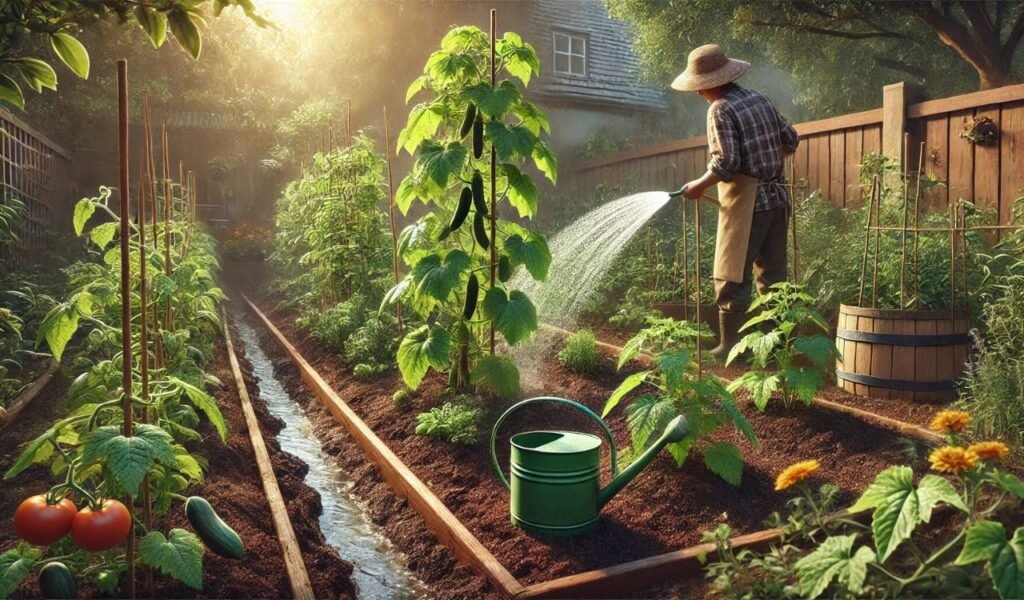
If you decide to plant cucumbers and tomatoes together, following a few simple best practices will help ensure a healthy, thriving garden:
Space them properly: Keep at least 12-18 inches between each plant to allow for air circulation and prevent overcrowding.
Use separate supports: Trellis your cucumbers while using stakes or cages for your tomatoes to keep their growth controlled.
Practice crop rotation: Avoid planting cucumbers and tomatoes in the same spot each year to prevent soil depletion and disease buildup.
Enrich the soil: Before planting, add compost, organic matter, or slow-release fertilizer to provide essential nutrients.
Water at the base: Watering at the soil level instead of from above will help prevent fungal diseases and keep plants healthy.
FAQ
Can cucumbers and tomatoes be planted together?
Yes, but they need proper spacing, support, and disease prevention to thrive.
How far apart should cucumbers and tomatoes be planted?
At least 12-18 inches apart, with proper trellising to prevent overcrowding.
Do cucumbers and tomatoes have the same soil needs?
Yes, both prefer well-draining, nutrient-rich soil with a pH between 6.0-7.0.
Can cucumbers and tomatoes share the same trellis?
It’s best to use separate supports to prevent them from tangling and competing for space.
Do cucumbers and tomatoes attract the same pests?
Yes, both can attract aphids, whiteflies, and fungal diseases, so pest control is important.
How often should I water cucumbers and tomatoes?
Water 2-3 times per week, keeping the soil moist but avoiding waterlogged conditions.
Can cucumbers and tomatoes grow together in containers?
Yes, but use large containers (at least 5 gallons per plant) and provide separate trellising.
Do cucumbers and tomatoes need the same fertilizers?
Both are heavy feeders, so use a balanced fertilizer but avoid excess nitrogen.
Final Thoughts
At the end of the day, planting cucumbers and tomatoes together is absolutely possible—but it requires careful planning to get the best results. By providing adequate spacing, proper trellising, and disease prevention, you can successfully grow both of these crops side by side and enjoy a bountiful harvest. If you’re a beginner gardener, don’t be afraid to experiment!
Gardening is all about learning and adapting as you go. Whether you’re planting in a backyard, raised bed, or indoor setup, cucumbers and tomatoes can be a great pair with the right care. So grab your seeds, set up your trellises, and start growing! Happy gardening!

